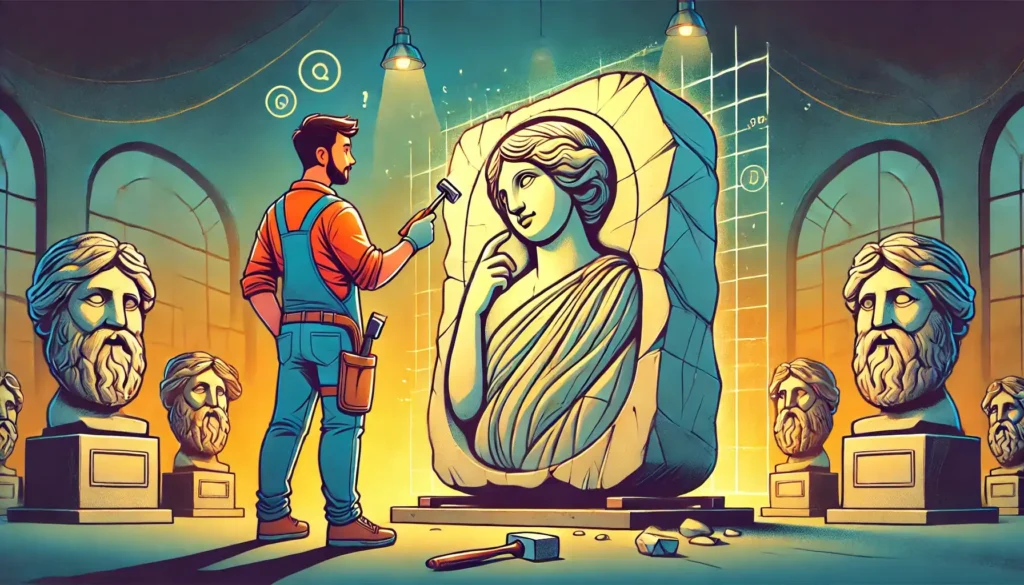Introduction: Creativity Can Be Your Best Ally or Your Biggest Obstacle
Imagine being in a lush forest, filled with intriguing paths and endless possibilities. Having many options might seem liberating, but as psychologist Barry Schwartz highlights in his study on the paradox of choice, an excess of alternatives can lead to indecision and hinder decision-making. Each trail represents a new idea—promising and exciting. However, without a map or compass, you may end up wandering aimlessly, lost in the vastness of possibilities. This is why learning how to organize ideas and turn them into action is a crucial skill in our lives.

Having many ideas is a gift. However, without knowing how to structure them, it’s like holding a handful of sand—slowly slipping through your fingers, leaving only the sensation of something lost. Creativity, when unorganized, can cause mental overload and paralysis: you know you have something valuable in your hands, but you simply can’t turn it into something concrete.
If you’ve ever felt this way, you’re not alone. Organizing your ideas is the first step to bringing projects to life and creating something meaningful. Let’s explore how to transform this creative energy into a practical and efficient process.
1. Shaping Ideas: The First Step to Mental Organization
Have you ever tried to remember all your ideas without writing them down? It’s like trying to stack leaves in the wind—it seems possible at first, but soon you realize they scatter before you can organize them. The human mind is incredible but also limited: the more you try to hold everything in your head, the more chaotic it becomes. The key is to create a dedicated space to capture your ideas clearly.

Record your ideas
Before filtering and prioritizing, start by recording everything. Whether in a notebook, an app, or a digital tool like Notion or Trello, the important thing is to have a place where you can unload your ideas without fear of forgetting them.
Quick tips:
- Use voice notes if speaking is easier than writing.
- Create broad categories (e.g., business ideas, digital content).
- Review this idea bank periodically.
Additionally, this step relieves mental pressure and prevents promising ideas from getting lost in the daily whirlwind of thoughts.
2. Refining Ideas: How to Identify What Really Matters
Not every idea is a good idea. Some are brilliant, others need adjustments, and some simply aren’t viable. But how do you decide?
Ask Key Questions
Before investing time and energy in an idea, ask yourself:
- Does this solve a real problem?
- Is there demand or an interested audience?
- Do I genuinely care about this idea?
- What resources are required to execute it?
By answering these questions, you automatically eliminate weak ideas and focus on what truly matters.
Avoid the temptation to tackle everything at once. Choose a limited number of ideas and concentrate on them before moving on to new initiatives.
3. Turning Ideas into Actionable Plans
Now that you’ve filtered your best ideas, it’s finally time to bring them to life. Think of each idea as a seed—without fertile soil and the right care, it will never grow. Many people fail at this stage because they don’t define a clear path for execution.

Set Small Steps and Clear Objectives
An idea without a plan is just a dream. Turn it into a project with specific goals:
- Set measurable targets – “Write a book” is vague. “Write 500 words a day” is a concrete goal.
- Break the idea into micro-steps – Small advances prevent creative block and provide a sense of progress.
- Create realistic deadlines – A clear timeline prevents you from getting stuck in the planning phase.
The more detailed your plan, the easier it will be to execute.
4. Maintaining Momentum and Avoiding Procrastination
Many projects die before they even take off due to a lack of discipline. To prevent this, create systems that ensure consistency.
Use the 5-Minute Rule
If a task feels overwhelming, commit to working on it for just five minutes. Often, the hardest part is simply getting started. This technique is a simple but incredibly effective trick to overcome inertia.
Have Monitoring Mechanisms
- Review your goals weekly.
- Set up a reward system (e.g., celebrate reaching milestones).
- Share your progress with someone—having another person’s perspective can boost commitment and reduce procrastination.
Conclusion: Creativity Needs Direction
Ultimately, having ideas is just the beginning. It’s like looking at a block of marble and envisioning the sculpture inside it—the real challenge lies in sculpting, shaping, and bringing form to what was once just a possibility. What truly matters is what you do with them. Organizing thoughts, setting priorities, and creating action plans are the keys to transforming creativity into results.

Now that you have a method for structuring your ideas, what’s the first step you’ll take today? Try applying these strategies and share your experience!
Expand Your Creativity
To continue enhancing your creativity and understand how even moments of distraction can be useful in the creative process, we recommend reading the article “How to Create Synapses While Procrastinating on Short Videos?” There, you’ll discover how consuming quick content can, instead of just being an escape, become a stimulus for new ideas and creative connections. It’s worth checking out!
Posts Recomendados
Carregando recomendações...



